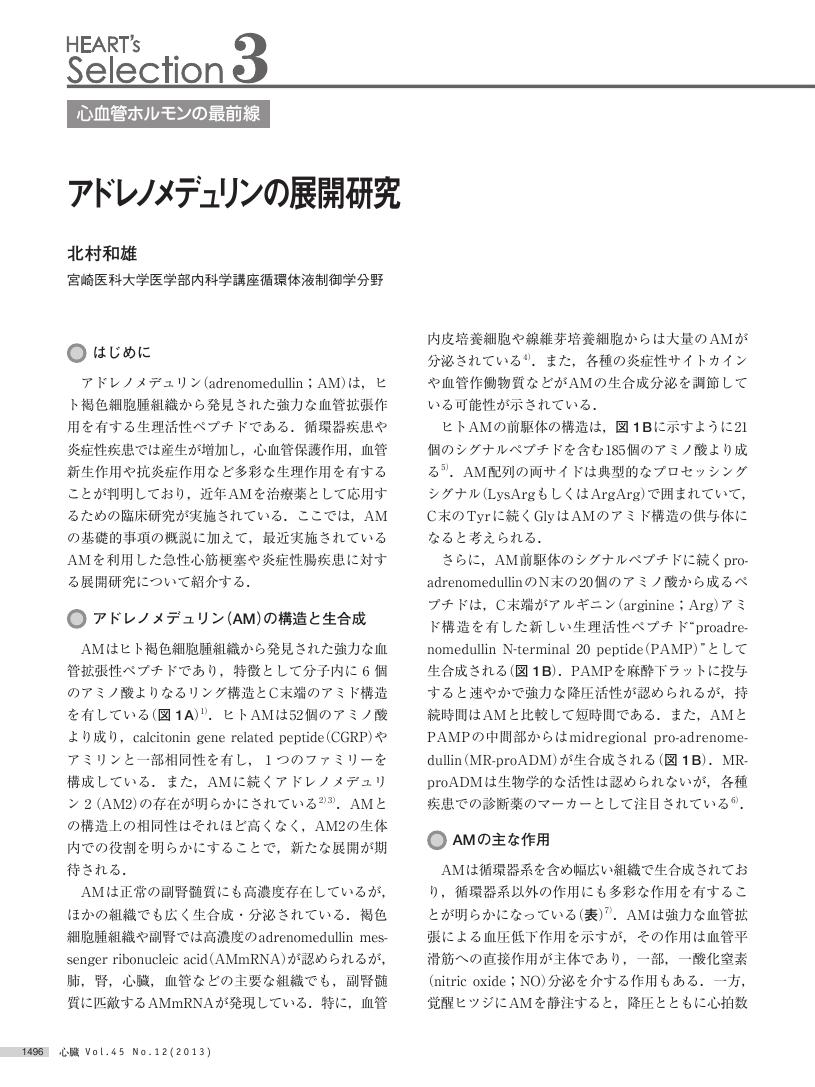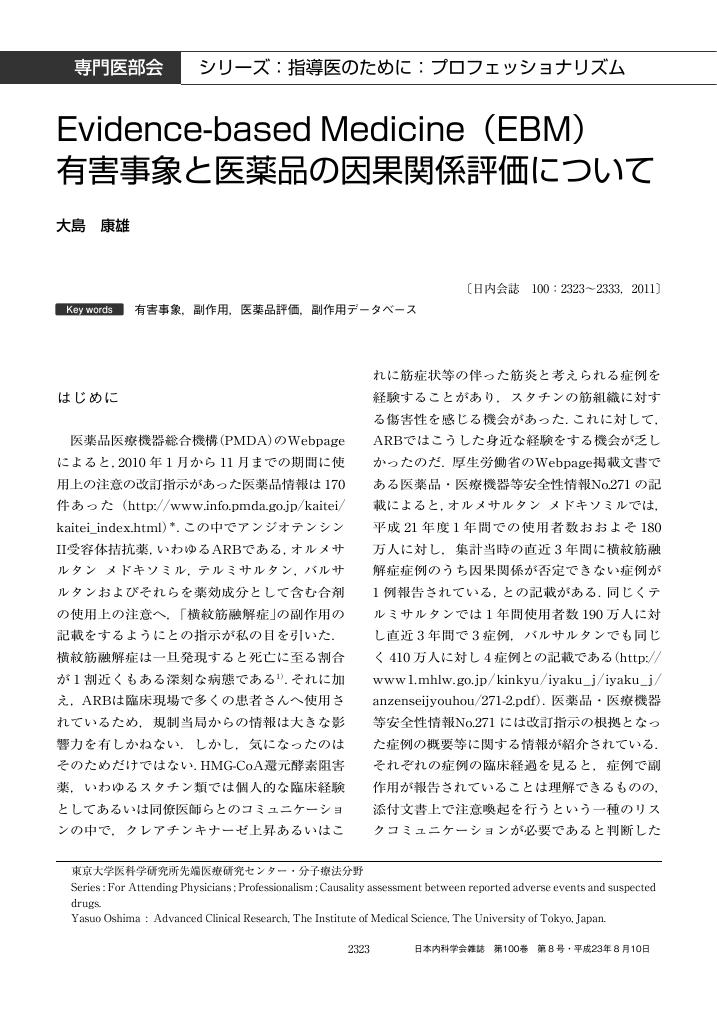5 0 0 0 OA アドレノメデュリンの展開研究
- 著者
- 北村 和雄
- 出版者
- 公益財団法人 日本心臓財団
- 雑誌
- 心臓 (ISSN:05864488)
- 巻号頁・発行日
- vol.45, no.12, pp.1496-1502, 2013 (Released:2014-12-27)
- 参考文献数
- 25
- 著者
- 高橋 洋一
- 出版者
- 日経BP社
- 雑誌
- 日経コンピュ-タ (ISSN:02854619)
- 巻号頁・発行日
- no.727, pp.42-45, 2009-04-01
1955年生まれ。78年東京大学理学部数学科卒業。80年東大経済学部経済学科卒業。同年大蔵省入省。大蔵省のALM(資産・負債管理)システムを設計。2003年から内閣府経済財政諮問会議特命室で道路公団改革や郵政民営化を手がける。特別会計積立・準備金などを指す"霞が関埋蔵金"の存在を指摘。08年4月から現職。
- 著者
- 髙橋 舞
- 出版者
- 教育思想史学会
- 雑誌
- 近代教育フォーラム (ISSN:09196560)
- 巻号頁・発行日
- vol.25, pp.152-158, 2016 (Released:2017-09-30)
5 0 0 0 OA 無脊椎動物における交替性転向反応研究の展開と問題点について
- 著者
- 川合 隆嗣
- 出版者
- 日本動物心理学会
- 雑誌
- 動物心理学研究 (ISSN:09168419)
- 巻号頁・発行日
- vol.61, no.1, pp.83-93, 2011 (Released:2011-07-15)
- 参考文献数
- 44
Turn alternation is the tendency of an organism during a single trial to turn in the opposite direction to a previous forced turn. It has been shown that this phenomenon depends on feedback from proprioceptive cues derived from prior response. Turn alternation has been studied mainly in invertebrates. An early explanation of invertebrate turn alternation was based on Hull's concept of reactive inhibition (Hull, 1943). However, more recent studies focus on the bilaterally asymmetrical leg movements (BALM) hypothesis which emphasizes activity differences between the right and left legs (Hughes, 1985). Additionally, many studies have shown variables that can modify turn alternation. The most commonly investigated are pre- and post- forced turn distances, the number of forced turns, and the angle of a forced turn. Although there are many studies which have investigated these variables, some of the results are conflicting because these studies tested different species with varying experimental designs. Further studies which control the experimental designs are needed to gain a further understanding of the nature of turn alternation.
5 0 0 0 OA 日米文化比較 : 日本人は集団主義か個人主義か
- 著者
- 高橋 正 Tadashi Takahashi
- 出版者
- 創価大学英文学会
- 雑誌
- 英語英文学研究 (ISSN:03882519)
- 巻号頁・発行日
- vol.43, no.1, pp.51-76, 2018-09-30
5 0 0 0 OA 複雑系モデルと応用物理
- 著者
- 『応用物理』編集委員会
- 出版者
- 公益社団法人 応用物理学会
- 雑誌
- 応用物理 (ISSN:03698009)
- 巻号頁・発行日
- vol.90, no.8, pp.469, 2021-08-05 (Released:2021-08-05)
5 0 0 0 IR 『おもろさうし』選詳解Ⅷ
- 著者
- 島村 幸一
- 出版者
- 立正大学文学部
- 雑誌
- 立正大学文学部研究紀要 = The Academic Journal of the Faculty of Letters Rissho University (ISSN:09114378)
- 巻号頁・発行日
- no.37, pp.1-51, 2021-03-19
5 0 0 0 8020達成者の口腔内模型および頭部X線規格写真分析結果について
- 著者
- 宮崎 晴代 茂木 悦子 斉藤 千秋 原崎 守弘 一色 泰成 鈴木 伸宏 関口 基 湯浅 太郎
- 出版者
- 日本矯正歯科学会
- 雑誌
- Orthodontic waves : journal of the Japanese Orthodontic Society : 日本矯正歯科学会雑誌 (ISSN:13440241)
- 巻号頁・発行日
- vol.60, no.2, pp.118-125, 2001-04-25
- 参考文献数
- 35
- 被引用文献数
- 11
本研究の目的は, 多数の歯を維持する日本人高齢者を対象として, その咬合および顎顔面形態を明らかにすることである.千葉市では毎年, 8020達成者を募集し千葉市主催の長生き良い歯のコンクールで表彰している.今回は平成10, 11年度の応募者41名に対し, アンケート調査および口腔内診査を実施し, その際口腔内及び顔面写真撮影, X線写真撮影, 印象採得を行い資料とした.応募者の平均年齢は82歳5カ月で, 平均現在歯数は25.3歯であった.年齢および現在歯数に男女差はなかった.咬合関係は, 前後的には上顎前突が78.9%, 正常が21.1%, 反対咬合は0%だった.垂直的には過蓋咬合が34.2%, 正常が65.8%, 開咬は0%だった.犬歯部アングル分はClass I (64.6%)とClass II (25.0%)が大半を占めた.叢生については, 上顎前歯部の叢生を有するものは4.9%と少なかった.下顎前歯部は31.7%に叢生を認めたが著しい叢生ではなかった.顎顔面形態については下顎骨が後下方回転し, やや上顎前突傾向を示した.以上により日本人8020達成者は比較的良好な咬合および顎顔面形態を有することがわかった.
5 0 0 0 IR 原爆の記憶と観音像 : 広島・長崎の公園の事例から
- 著者
- 君島 彩子 Ayako KIMISHIMA キミシマ アヤコ
- 出版者
- 総合研究大学院大学文化科学研究科
- 雑誌
- 総研大文化科学研究 (ISSN:1883096X)
- 巻号頁・発行日
- no.11, pp.143-159, 2015-03
本稿は、広島と長崎の公園に建立された観音像の事例から、原爆の記憶について論じたものである。観音像は「原爆死者」や「原爆災禍」の記憶を伝える造形物であり、二面的な記憶を想起させる。一方は原爆投下という「社会的な出来事」と原爆による「集団的で匿名の死者」の記憶であり、もう一方は近親者など「顔の分かる死者」の記憶である。本稿では、原爆災禍と集団的な原爆死者の記憶を想起させる役割を「モニュメント」、個人的な死者の記憶を想起させる役割を「墓標」と定義し、爆心地の公園に建立された観音像の分析を行う。墓地とも関わりの深い仏像は、家族や友人など顔を思い出すことのできる死者を記憶し、慰霊するために立てられることが多く、「墓標」としての役割が強いが、仏像の中でも観音像は、近代的な思想の中で神聖化された「母性」の象徴とされることでモニュメンタルな意味を持つことがある。近代的な「母性」の象徴としての観音は、「軍国主義」に対して「新しい国家」のアレゴリーとして捉えられ、「平和」の象徴となった。つまり観音像には、「墓標」と「モニュメント」双方の意味が内在されているのである。原爆によって一瞬にして焼け野原となった広島と長崎の爆心地付近は公園として整備され、毎年8月には大規模な平和記念式典が行われている。行政によって作られた公園は、原爆災禍の記憶を伝える巨大な「モニュメント」ともいえる。しかし、公園となっている場所は、多くの人々の命が失われた場所であり、式典が行われる日は彼らの命日である。式典当日、公園内の観音像の参拝者から聞き取り調査をおこなった結果、観音像によって原爆で亡くなった親族の記憶や、かつての暮らしの記憶が思い出されていることが明らかになった。公園という公共空間の観音像も、その場所の記憶や遺骨との関係性によって、個人的な死者の記憶を想起させる「墓標」の意味を含んでいる。しかし、碑文によって説明を行なう「原爆碑」とは異なり、観音像のもつ意味は変化しやすいため、対面的な死者の記憶をもつ人間がいなくなった時、その意味が変化すると考えられる。This paper discusses how the statues of Kannon (Avalokitesvara) in the peace parks that were established in the hypocenters in Hiroshima and Nagasaki have helped to pass on the memory of the "atom bomb dead" and the "atom bomb disaster." The statues of Kannon that have been erected there serve as one form of monument. I consider that there are two directions in the "memory" thus represented. One is the "social event" of the atomic bombing and memory directed toward the "collective anonymous dead," and the other is memory directed toward the "dead with names." In this analysis, the statue of Kannon, representing memory in the social and anonymous direction, is classified as a monument, and memory in the individual direction is classified as a grave marker. As an object of Buddhist belief, the statue of Buddha is often established for the worship and remembrance of the dead whose faces their friends and families can still remember and for whom the meaning of grave marker is stronger. However, among all the images of Buddha, the statue of Kannon has also come to be a monument, as a symbol in latter-day thought of "motherhood" as well as a monument conveying the tragic memory of the atom bomb as an allegory of "peace" and "post-war Japan." The peace parks, developed after the war in the hypocenters of Hiroshima and Nagasaki that instantly became burnt-out areas due to the atom bombs, are where today large-scale peace memorial ceremonies are held every August. I have interviewed people who have come to pray during the August ceremonies. As a result, I have learned about their family members who died on the sites of the peace parks. Because the current peace parks are the places where their relatives lost their lives, the days of the peace memorial ceremonies have also become for the families the days for family commemoration of the anniversary of their deaths. The peace parks established by the nation have also become huge "monuments" to tell the memory of the collective dead to the countless number of people who visit there. However, different from a monument written in characters, the statues of Kannon in the parks have also become grave markers to evoke the memory of the individual dead. This meaning of the statues of Kannon may change, and may eventually come to express folk beliefs in Buddha, or another allegory of "peace" as a part of the larger monument complex, when living persons no longer have a memory of the individuals who perished there.
- 著者
- 福田 麻莉
- 出版者
- 日本教育実践学会
- 雑誌
- 教育実践学研究 (ISSN:1344946X)
- 巻号頁・発行日
- vol.21, no.1, pp.1-14, 2019 (Released:2021-05-08)
- 参考文献数
- 28
本研究は,認知カウンセリングの事例分析を通じて,授業および家庭学習における中学生の教科書・ノートの活用を促す方法についての示唆を得ることを目的とした.本事例では,カウンセラーはカウンセリング中,数学の教科書を活用し,また,クライエントに学習内容についての説明を求めることで,教科書の内容や構成についての理解を促し,家庭学習中に分からないことがあった際に自発的に教科書を見返すようになることを狙った.カウンセリングを通じて,クライアントは家庭でも教科書を自発的に使用するようになり,また,数学の用語や概念の意味を重視する学習観を抱くようになった.さらに,授業中のノートテイキングにも変化が見られ,用語や概念の意味についてのメモを取ることができるようになった.分析を通じて,教科書やノートを活用できる,自立的な学習者を育成する上での効果的な介入方法についての示唆が得られた.
5 0 0 0 懸念の表明
- 著者
- 佐藤 寛
- 出版者
- 一般社団法人 日本認知・行動療法学会
- 雑誌
- 認知行動療法研究 (ISSN:24339075)
- 巻号頁・発行日
- vol.47, no.1, pp.61, 2021-01-31 (Released:2021-05-18)
5 0 0 0 OA 試験に絶対出ない英単語
- 著者
- 安藤 聡
- 出版者
- 愛知大学名古屋語学教育研究室
- 雑誌
- 語研ニュース = Goken News
- 巻号頁・発行日
- no.16, pp.3-7, 2006-12
- 著者
- 大島 康雄
- 出版者
- 一般社団法人 日本内科学会
- 雑誌
- 日本内科学会雑誌 (ISSN:00215384)
- 巻号頁・発行日
- vol.100, no.8, pp.2323-2333, 2011 (Released:2013-04-10)
- 参考文献数
- 5
- 被引用文献数
- 1 1
5 0 0 0 IR アメリカ合衆国憲法と古典古代
- 著者
- 原田 俊彦
- 出版者
- 早稲田大学法学会
- 雑誌
- 早稻田法學 (ISSN:03890546)
- 巻号頁・発行日
- vol.92, no.3, pp.39-87, 2017-03-30
5 0 0 0 OA 体力の性差を踏まえた運動・スポーツ
- 著者
- 加賀谷 淳子
- 出版者
- 公益財団法人 日本学術協力財団
- 雑誌
- 学術の動向 (ISSN:13423363)
- 巻号頁・発行日
- vol.11, no.11, pp.52-53, 2006-11-01 (Released:2009-12-21)
- 参考文献数
- 3
5 0 0 0 OA ヤマイグチ亜科(イグチ科イグチ目)に含まれる日本産地下生菌の多様性と分類
- 著者
- 折原 貴道
- 出版者
- 日本菌学会
- 雑誌
- 日本菌学会会報 (ISSN:00290289)
- 巻号頁・発行日
- vol.61, no.2, pp.63-80, 2020-11-01 (Released:2020-12-18)
- 参考文献数
- 51
地下生菌とは元来,子実体が地表に露出せず,胞子の能動的散布を行わない大型菌類を指すが,現在では.地上生か地下生かに拘わらず,このような菌に共通する形態的・進化的特性を備えた菌類を広く指す場合が多い.日本における地下生菌の多様性や分類に関する研究は近年急速に進展し,現在では,日本列島が世界的にも有数の高い地下生菌多様性を誇る地域であることが認知されつつある.本稿では,近年特に多様性の解明が著しい,イグチ科ヤマイグチ属およびクロヤマイグチ属に近縁な4属(Chamonixia [アオゾメタマイグチ属(新称)],Octaviania[ホシミノタマタケ属],Rossbeevera [ツチダマタケ属],Turmalinea [ベニタマタケ属])の地下生菌について,近年の分類体系を紹介するとともに,日本産全既知分類群の簡易的な記載および解説を加えた.さらに,和名がついていない分類群については新称を与えた.
5 0 0 0 OA 大学入学者選抜と「総合的かつ多面的な評価」 ――46答申で示された科学的根拠の再検討――
- 著者
- 木村 拓也
- 出版者
- 日本教育社会学会
- 雑誌
- 教育社会学研究 (ISSN:03873145)
- 巻号頁・発行日
- vol.80, pp.165-186, 2007-05-31 (Released:2018-07-01)
- 参考文献数
- 47
- 被引用文献数
- 1
The purpose of this paper is to reexamine the use of “Comprehensive and Multi-dimensional Evaluation” as the basis for University Entrance Examinations. Though the phrase “Comprehensive and Multi-dimensional Evaluation” itself was first articulated in the 1997 report of the Central Council for Education (Chuou Kyoiku Shingikai), the concept itself came into existence immediately after the postwar period. In fact, “comprehensive evaluation” was merely an excuse for avoiding having to add the score of Japanese Scholastic Aptitude Test (Shingaku Tekisei Kensa, used from 1947 to 1954) into the total score of the University Entrance Examination. Moreover, the term “multi-dimensional evaluation” appeared in the outline of the University Entrance Examination (Daigaku Nyugakusha Senbatsu Jisshi Youkou), as it is proposed in the first report of the National Council on Educational Reform (Rinji Kyoiku Shingikai) in 1985.In fact, the report of the Central Council for Education (Chuo Kyoiku Shingikai) in 1971 stated that “Comprehensive and Multi-dimensional Evaluation” was scientifically valid as a basis for University Entrance Examinations. The report is famous as the only report based on evidence, and is generally known as the “1971 Report” (Yonroku Toushin). In the interim report, the Central Council for Education stated that follow-up surveys by the National Institute for Education and the Educational Test Research Institute (Nouryoku Kaihatu Kenkyujyo) had proven that a “Comprehensive and Multi-dimensional Evaluation” could be a valid selection method for predicting a good Grade Point Average after entrance to university.However, the two surveys cited contained simple statistical errors. The first, survey by the National Institute for Education, failed to control for the “Selection Effect.” A “Selection Effect” is a “restriction in range problem,” caused by cutting off the distribution at the passing grade. As a result, there is a tendency to misunderstand the fact that, in actuality, academic achievement tests on University Entrance Examinations have little relationship with Grade Point Average after entering university. To tell the truth, this problem had been pointed out as early as 1924 by Japanese psychologists who were interested in Entrance Examinations. In the second survey, by the Educational Test Research Institute, the inevitable nature of multiple correlation coefficients was ignored. As the number of independent variable increases one by one, the multiple correlation coefficient necessarily reaches the maximum of 1. In this paper, the follow-up research data from the Educational Test Research Institute is recalculated using a multiple correlation coefficient adjusted for the degrees of freedom. The conclusion is different from that reached by the Central Council for Education.This demonstrates that there is absolutely no scientific ground for the use of “Comprehensive and Multi-dimensional Evaluation.” In other words, it is not necessarily correct that putting a lot of effort into University Entrance Examinations and using anything more than academic achievement tests as reference for University Entrance Examination will lead to more students gaining good grades after entering university. If this mismeasure of academic achievement is not properly recognized, the number of university students who cannot achieve even low basic competence level will surely increase.
5 0 0 0 IR 地域振興のためのミニ独立国のいま : 奈良県下北山村"ツチノコ共和国"の事例から
- 著者
- 白石 太良 野崎 和生
- 出版者
- 兵庫地理学協会
- 雑誌
- 兵庫地理 = Hyogo geographical journal (ISSN:13414054)
- 巻号頁・発行日
- no.64, pp.67-78, 2019




